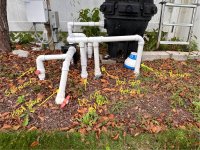 Hi, I have a pool in which the plumbing near the equipment has valves near or in the dirt. This makes turning the valve on/off a pain some times, especially when it’s outside. In addition, you can see, in the picture, some of the valve handles has broken. There is also on valve on the return side that I do not know where it goes. My initial thought is to fix the valve and move the other valves higher up by about 6 inches next spring. Since, I’m doing the work, I‘d thought I reach out to this forum and get feedback if I can improve the piping near the equipment. Appreciate any suggestions? For example, I have a cartridge filter, does it make sense to plumbing in a waste line, so I can lower the pool quicker (currently using a 1200 gal / hr pump, very slow).
Hi, I have a pool in which the plumbing near the equipment has valves near or in the dirt. This makes turning the valve on/off a pain some times, especially when it’s outside. In addition, you can see, in the picture, some of the valve handles has broken. There is also on valve on the return side that I do not know where it goes. My initial thought is to fix the valve and move the other valves higher up by about 6 inches next spring. Since, I’m doing the work, I‘d thought I reach out to this forum and get feedback if I can improve the piping near the equipment. Appreciate any suggestions? For example, I have a cartridge filter, does it make sense to plumbing in a waste line, so I can lower the pool quicker (currently using a 1200 gal / hr pump, very slow).Additionally, the electric outlets for the 110v and the pump is also touching the ground. Is there a reason for keeping it so close to the ground? Would there be any problems if I move the outlets about 4 inches off the ground?
Thank you.

